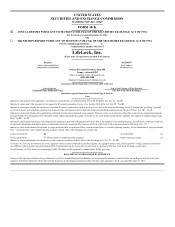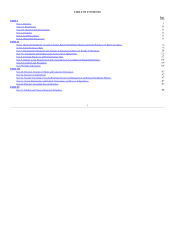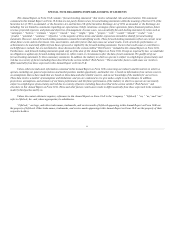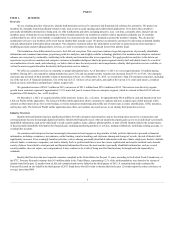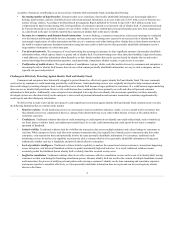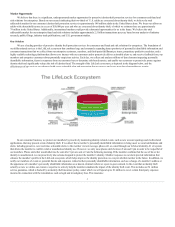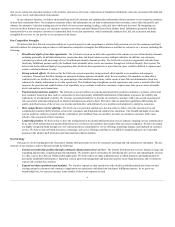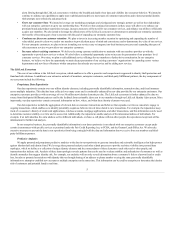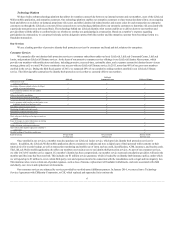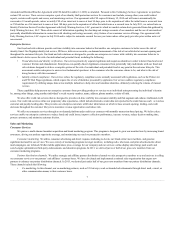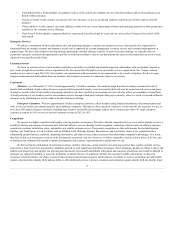LifeLock 2013 Annual Report Download - page 5
Download and view the complete annual report
Please find page 5 of the 2013 LifeLock annual report below. You can navigate through the pages in the report by either clicking on the pages listed below, or by using the keyword search tool below to find specific information within the annual report.
A number of trends are contributing to an increased rate of identity theft and identity fraud, including the following:
• . Enterprises that act as custodians of personally identifiable information are increasingly subject to
hacking, data breaches, and loss of mobile devices with stored personal information, as we saw at the end of 2013 with a series of breaches at a
number of large retailers. According to the Data Breach Investigations Report published by Verizon in April 2013, 44.8 million records were
compromised by data breaches during 2012, leaving millions of consumers exposed to an increased risk of identity theft. A commissioned study
by Forrester Research on our behalf estimates two out of three of those who were notified their personal information may have been compromised
in a data breach in the past 12 months reported they experienced identity theft in the past 12 months.
• . As more banking, e-commerce transactions, and account openings are conducted
over the Internet and through mobile devices, consumers and enterprises are becoming more exposed to an increased risk of identity theft. The
increasingly simple nature of online transactions and the ease of e-commerce and online banking allow identity thieves from almost anywhere in
the world to conduct numerous fraudulent transactions using the same credit or debit card or other personally identifiable information across a
large number of enterprises in a short time span.
•. The emergence of social networking has encouraged consumers to share significant amounts of personally identifiable
information online, which exposes them to a greater risk of identity theft. Social networking users often share their birthdays, high school names,
e-mail addresses, and other information about themselves or their family members that can be accessed easily by identity thieves and used to
answer knowledge-based authentication questions, crack passwords, compromise identity security, or gain access to accounts.
•. The rapid adoption of smartphones, laptops, tablets, and other mobile devices by consumers and enterprises is
increasing the risk of identity theft because these devices often contain personally identifiable information, are easy to steal or misplace, and are
typically not password protected.
Consumers and enterprises have historically struggled to protect themselves effectively against identity theft and identity fraud. The most commonly
used service by consumers is credit monitoring provided by credit bureaus. Credit monitoring services were originally developed to help consumers monitor
their credit ratings by tracking changes to their credit profiles, but as identity theft became a larger problem for consumers, th e credit bureaus began marketing
these services as identity theft protection. However, the credit bureaus have continued their focus primarily on credit and often sell personal consumer
information to third parties. Additionally, some enterprises have attempted to develop their own identity risk assessment capabilities, but these internally
developed systems are often based solely on the enterprise’s own records of personal information and customer transactions, sometimes supplemented by
credit reports and other third-party information.
We believe that in order to provide the most proactive and comprehensive protection against identity theft and identity fraud, solutions must overcome
the following limitations that are common in the market:
•. Credit monitoring services are not proactive and can sometimes take days, weeks, or even a month to alert consumers that
their identities have been compromised; however, damage from identity theft may occur either within minutes or hours of the identity theft or
sometimes years later.
•. Traditional solutions that rely on credit monitoring or credit reports do not identify non-credit-related fraud, such as bank fraud,
tax fraud, phone or utilities fraud, and employment-related fraud. As a result, credit monitoring and credit reports do not assess a complete
spectrum of fraud risk.
•. Traditional solutions lack the visibility into transaction data across multiple industries and a direct linkage to consumers in
real time. While enterprises closely track their own customer transaction data, they typically have limited access to transaction data from other
enterprises, even transactions that could potentially involve the same personally identifiable information. For consumers, traditional credit
monitoring services do not have the capability to proactively alert a consumer that his or her personally identifiable information is being used,
authenticate whether such use is fraudulent, and provide that feedback to enterprises.
•. Traditional solutions lack the capability to analyze the connections between consumers, transactions happening
across enterprises, and historical fraudulent activities to predict and identify high-risk activities. As a result, traditional solutions cannot
accurately predict the likelihood that an identity theft or identity fraud has occurred or may occur.
•. Traditional solutions often do not offer consumers effective remediation services in the event of an identity theft, leaving
consumers on their own during the frustrating remediation process. Because identity theft can result in the creation of multiple fraudulent accounts
and transactions, the process of notifying relevant parties and restoring a consumer’s identity can be time consuming and sometimes expensive
and require expertise to remediate effectively, as stolen personally identifiable information does not expire and can be reused again by identity
thieves in the future.
2

